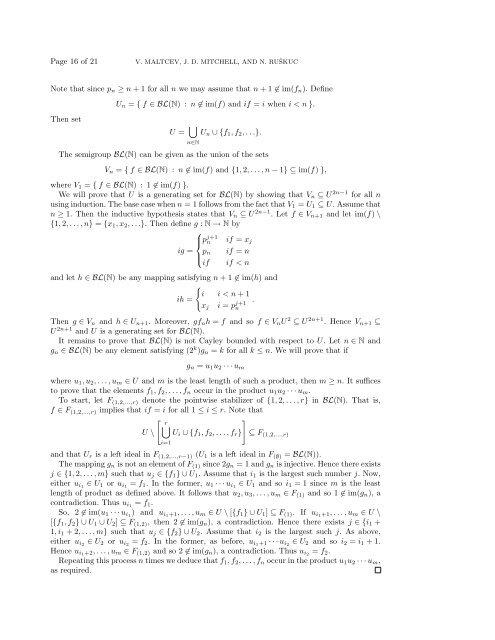The Bergman property for semigroups
The Bergman property for semigroups
The Bergman property for semigroups
You also want an ePaper? Increase the reach of your titles
YUMPU automatically turns print PDFs into web optimized ePapers that Google loves.
Page 16 of 21<br />
V. MALTCEV, J. D. MITCHELL, AND N. RUŠKUC<br />
Note that since p n ≥ n + 1 <strong>for</strong> all n we may assume that n + 1 ∉ im(f n ). Define<br />
U n = { f ∈ BL(N) : n ∉ im(f) and if = i when i < n }.<br />
<strong>The</strong>n set<br />
U = ⋃ n∈N<br />
U n ∪ {f 1 , f 2 , . . .}.<br />
<strong>The</strong> semigroup BL(N) can be given as the union of the sets<br />
V n = { f ∈ BL(N) : n ∉ im(f) and {1, 2, . . . , n − 1} ⊆ im(f) },<br />
where V 1 = { f ∈ BL(N) : 1 ∉ im(f) }.<br />
We will prove that U is a generating set <strong>for</strong> BL(N) by showing that V n ⊆ U 2n−1 <strong>for</strong> all n<br />
using induction. <strong>The</strong> base case when n = 1 follows from the fact that V 1 = U 1 ⊆ U. Assume that<br />
n ≥ 1. <strong>The</strong>n the inductive hypothesis states that V n ⊆ U 2n−1 . Let f ∈ V n+1 and let im(f) \<br />
{1, 2, . . . , n} = {x 1 , x 2 , . . .}. <strong>The</strong>n define g : N → N by<br />
⎧<br />
⎪⎨ p j+1<br />
n if = x j<br />
ig = p n if = n<br />
⎪⎩<br />
if if < n<br />
and let h ∈ BL(N) be any mapping satisfying n + 1 ∉ im(h) and<br />
{<br />
i i < n + 1<br />
ih =<br />
x j i = p j+1 .<br />
n<br />
<strong>The</strong>n g ∈ V n and h ∈ U n+1 . Moreover, gf n h = f and so f ∈ V n U 2 ⊆ U 2n+1 . Hence V n+1 ⊆<br />
U 2n+1 and U is a generating set <strong>for</strong> BL(N).<br />
It remains to prove that BL(N) is not Cayley bounded with respect to U. Let n ∈ N and<br />
g n ∈ BL(N) be any element satisfying (2 k )g n = k <strong>for</strong> all k ≤ n. We will prove that if<br />
g n = u 1 u 2 · · · u m<br />
where u 1 , u 2 , . . . , u m ∈ U and m is the least length of such a product, then m ≥ n. It suffices<br />
to prove that the elements f 1 , f 2 , . . . , f n occur in the product u 1 u 2 · · · u m .<br />
To start, let F (1,2,...,r) denote the pointwise stabilizer of {1, 2, . . . , r} in BL(N). That is,<br />
f ∈ F (1,2,...,r) implies that if = i <strong>for</strong> all 1 ≤ i ≤ r. Note that<br />
[ r<br />
]<br />
⋃<br />
U \ U i ∪ {f 1 , f 2 , . . . , f r } ⊆ F (1,2,...,r)<br />
i=1<br />
and that U r is a left ideal in F (1,2,...,r−1) (U 1 is a left ideal in F (∅) = BL(N)).<br />
<strong>The</strong> mapping g n is not an element of F (1) since 2g n = 1 and g n is injective. Hence there exists<br />
j ∈ {1, 2, . . . , m} such that u j ∈ {f 1 } ∪ U 1 . Assume that i 1 is the largest such number j. Now,<br />
either u i1 ∈ U 1 or u i1 = f 1 . In the <strong>for</strong>mer, u 1 · · · u i1 ∈ U 1 and so i 1 = 1 since m is the least<br />
length of product as defined above. It follows that u 2 , u 3 , . . . , u m ∈ F (1) and so 1 ∉ im(g n ), a<br />
contradiction. Thus u i1 = f 1 .<br />
So, 2 ∉ im(u 1 · · · u i1 ) and u i1+1, . . . , u m ∈ U \ [{f 1 } ∪ U 1 ] ⊆ F (1) . If u i1+1, . . . , u m ∈ U \<br />
[{f 1 , f 2 } ∪ U 1 ∪ U 2 ] ⊆ F (1,2) , then 2 ∉ im(g n ), a contradiction. Hence there exists j ∈ {i 1 +<br />
1, i 1 + 2, . . . , m} such that u j ∈ {f 2 } ∪ U 2 . Assume that i 2 is the largest such j. As above,<br />
either u i2 ∈ U 2 or u i2 = f 2 . In the <strong>for</strong>mer, as be<strong>for</strong>e, u i1+1 · · · u i2 ∈ U 2 and so i 2 = i 1 + 1.<br />
Hence u i1+2, . . . , u m ∈ F (1,2) and so 2 ∉ im(g n ), a contradiction. Thus u i2 = f 2 .<br />
Repeating this process n times we deduce that f 1 , f 2 , . . . , f n occur in the product u 1 u 2 · · · u m ,<br />
as required.
















